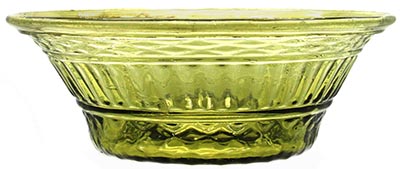Kent G.II-6 Blown Three Mold Bowl
by Paul Kirk

Many collectors dream of discovering a pristine piece of historic American glassware. Glass is inherently fragile, and its survival rate is perhaps lower than that of other antiques. What one generation treasures might not be valued by subsequent generations, and items often end up neglected and unappreciated. It is interesting to muse where the antique glassware we collect and love has been prior to our acquisition of it. Were the items valued and treasured as much as we value and treasure them today, or were they neglected in the backs of dark, dusty cupboards? Leaving items untouched in the back of cupboards for generations often protects them from use and breakage, but all it takes is one unfortunate mishap, and a historic item can be lost forever. Considering the latter, it is almost a miracle that fragile, 200-year-old American glassware has survived. For it to survive in as perfect condition as possible for its age is truly remarkable. The Kent G.II-6 bowl that Norman C. Heckler & Company will be featuring at auction is such an example of an extremely rare and remarkable piece early American glassware.
Kent, Ohio, is the largest city in Portage County and was settled as part of the Connecticut Western Reserve in 1805. It encompasses areas known early on as Carthage and Franklin Mills. The area drew settlers because of its location along the Cuyahoga River which was ideal for water-powered mills. During the mid-nineteenth century, Franklin Mills was noted for its involvement with the Underground Railroad. In 1864 Franklin Mills was renamed Kent in honor of Marvin Kent, who was responsible for bringing the railroad through the town in 1863. This played a major role in the development of the village. Kent was incorporated as a village in 1867 and became a city after the issuance of the 1920 Census. Kent is now best known as a small college town. It is the home of the main campus of Kent State University which was founded in 1910.
Glass factories were established in Kent, Ohio, in the early 19th century. In their book, American Glass, George S. and Helen McKearin make mention of a glass house called Park, Edmunds & Parks. They refer to the pattern on the Kent bowl as G.II-6 and attribute it to that specific glass house due to excavations done at the site. G.II-6, as described by the McKearins, is a "band of vertical ribbing between bands of diamond diapering and at the top a band of gadrooning."
The classification "blown three mold" was coined in the 1920s when the glass, then approximately a century old, was being noticed by collectors. In August 1924 The Magazine Antiques published an article by Helen McKearin which was apparently the first that dealt exclusively with this type of glass. At that time, "Three Mold" was the name used by collectors. The addition of the word "blown" came from discussion and agreement between Homer Eaton Keyes and Helen McKearin, and in December 1929, she wrote another article for The Magazine Antiques titled "Fiction of Three-mold Glass." Though collectors fully understood that "Three Mold" referred to the glass being discussed, McKearin and Keyes felt that adding the word "blown" to the name would eliminate any confusion with collectors between it and pressed glass made in three-part molds. To this day, due to the association with this early glass, many collectors feel that all pressed glass made in three-part molds is "early," but the number of mold marks on pressed glass has more to do with the design itself rather than its age.
Blown Three Mold glass was made in full-size metal molds, and the period of its production began about 1820. The designs were modeled after much more costly imported English and Irish cut glass. Two-part and four-part molds were also used, but the vast majority of molds were three parts, and though full-sized molds were used, hand tooling was utilized for many items. The McKearins aptly describe the visual impact of three mold blown glass in an eloquent manner: "Blown Three mold pieces typically show softened forms and angles and an uneven fidelity to the mold. However, the way in which the concavo-convex surfaces refract the light increases the effect of diffuseness and largely accounts for the typical brilliance, popularly called 'liquid brilliance.'"
The McKearins mention that bowls, usually flared, in the G.II-6 pattern are mostly found in light green, but more straight-sided ones are known in what they refer to as "olive-yellow." The Heckler G.II-6 Kent bowl might be described as "olive-yellow," but other early glass aficionados have referred to the color as "citron." Color can be quite a subjective thing. I have had the pleasure of handling the Heckler bowl, and the color in natural light certainly could be called citron. In addition to its vivid color and "liquid brilliance," the form is very appealing.
The Kent G.II-6 bowl to be auctioned by Heckler was found in Byler's Flea Market, which was located in Hartville, Ohio, in the late 1990s or early 2000s. Byler's Flea Market was part of the old Hartville flea market complex. It is amazing that the bowl was discovered approximately fifteen miles due south of where it was made nearly two centuries prior. The seller had various items from his aunt's home on his table and was set up in a parking lot about twenty feet away from the entrance of an antiques mall. The bowl was priced $5.
This bowl will be offered at www.HecklerAuction.com, Auction #210, August 17-31, 2022.
For more information:
Call the Norman C. Heckler & Company office at 860-974-1634
or
Email: info@hecklerauction.com

